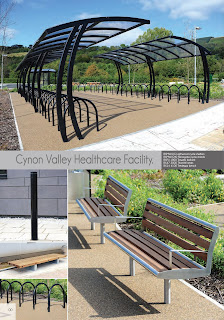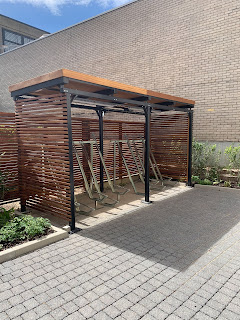Cycle Stand Design:
A well-designed cycle stand should be functional, durable, and aesthetically pleasing. It should securely hold bicycles, protect them from theft and damage, and provide convenience for cyclists. Here are some key considerations for designing a cycle stand:
1. **Type of Material:** Common materials for cycle stands include steel, stainless steel, aluminum, and galvanized steel. Steel is a popular choice due to its strength and durability, while stainless steel is resistant to corrosion. Aluminum is lightweight and also resistant to corrosion, making it a good option for outdoor stands.
2. **Design:** The design of the cycle stand should provide ample support for bicycles while allowing for easy locking. It should also take into account the available space and the number of bicycles the stand needs to accommodate.
3. **Security:** Consider incorporating locking mechanisms or spaces for cyclists to secure their bikes with their own locks.
4. **Aesthetics:** An attractive design can enhance the overall look of the area. Consider incorporating clean lines and a modern aesthetic.
Types of Material for a Cycle Stand:
1. Steel: Strong and durable, but may require maintenance to prevent rust.
2. Stainless Steel: Resistant to corrosion, low maintenance, and visually appealing.
3. Aluminum: Lightweight and corrosion-resistant, ideal for outdoor use.
4. Galvanized Steel: Coated with zinc to resist rust, a cost-effective option.
Estimated Cost of a Cycle Stand:
The cost of a cycle stand can vary based on material, design complexity, size, and additional features like locking mechanisms. On average, a basic cycle stand can range from $50 to $150 per unit, while more advanced designs or custom stands can go upwards of $300 to $500 per unit. Bulk purchasing may offer cost savings.
**Flooring for a Cycle Stand:**
The flooring around a cycle stand should be durable and easy to maintain. Common options include concrete, asphalt, interlocking pavers, or even a dedicated bike rack pad. The flooring should be level to ensure stability for cyclists using the stand.
**Roofing for a Cycle Stand:**
Not all cycle stands require roofing, but if you want to provide protection from the elements, you can consider options like a simple canopy, a metal or fabric cover, or a small shelter with a roof.
**Minimum Cost:
The minimum cost for a basic cycle stand, with simple steel construction, no added security features, and no roofing or flooring would likely be around $50 to $100 per unit. However, this cost can increase based on the factors mentioned above. It's essential to balance cost with the functionality and durability of the cycle stand for a successful design.
Title: The Benefits of Galvanized Iron (GI) Roofing Compared to Concrete Roofing
Introduction:
When it comes to roofing options, two popular choices are galvanized iron (GI) and concrete roofing. Both materials offer unique advantages, but GI roofing stands out as a reliable and cost-effective option. In this article, we will explore the benefits of GI roofing compared to concrete roofing, highlighting its durability, cost-efficiency, ease of installation, and aesthetic appeal.
1. Durability:
GI roofing is renowned for its exceptional durability, making it an excellent choice for various weather conditions. The galvanization process involves coating iron or steel with a layer of zinc, which provides a protective barrier against rust and corrosion. This galvanized coating ensures that the roofing remains intact even in harsh environments, such as coastal regions with high humidity or areas prone to heavy rainfall. In contrast, concrete roofing may be susceptible to cracking or chipping over time, particularly in regions with significant temperature fluctuations.
2. Longevity:
One of the most compelling benefits of GI roofing is its longevity. A well-maintained GI roof can last for several decades, with a life span of around 50 years or more. This longevity surpasses concrete roofing, which typically has a lifespan of around 30 to 40 years. The extended life cycle of GI roofing translates to long-term savings, as it reduces the need for frequent replacements and repairs.
3. Cost-efficiency:
GI roofing offers significant cost advantages compared to concrete roofing. The upfront installation costs for GI roofing are generally lower due to the affordability of galvanized iron materials. Additionally, the ease of transportation and installation of GI roofing further contributes to cost savings. Moreover, the extended lifespan of GI roofing reduces maintenance and replacement expenses over the years, making it a more economical investment in the long run.
4. Easy Installation and Lightweight:
Installing GI roofing is a straightforward process, and its lightweight nature simplifies transportation and handling on-site. Concrete roofing, on the other hand, requires more complex installation methods and might necessitate additional structural support due to its weight. The ease and speed of GI roofing installation can significantly reduce construction time, allowing projects to be completed faster.
5. Aesthetic Appeal and Versatility:
GI roofing offers a wide range of design options and finishes, making it a versatile choice for various architectural styles. Whether you prefer a traditional or contemporary look, GI roofing can be customized to complement your desired aesthetic. Concrete roofing, while durable, may lack the aesthetic flexibility provided by GI roofing, limiting design possibilities.
Conclusion:
In conclusion, galvanized iron (GI) roofing proves to be a superior choice when compared to concrete roofing. Its durability, longevity, cost-efficiency, ease of installation, and aesthetic appeal make it an attractive option for residential, commercial, and industrial roofing needs. GI roofing provides peace of mind for homeowners and building owners alike, knowing they have a reliable, long-lasting, and cost-effective roofing solution that can withstand the test of time and weather.
 Reviewed by Rehan Qamar
on
August 10, 2023
Rating:
Reviewed by Rehan Qamar
on
August 10, 2023
Rating:







.jpeg)






No comments:
Please click on follower button